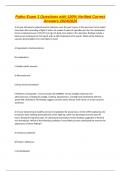-
1. Exam (elaborations) - Nur 2063 pathophysiology exam 1 2022
-
2. Exam (elaborations) - Chapter 01 - pathophysiology 2022
-
3. Exam (elaborations) - Nur-641e advanced pathophysiology and pharmacology for the nurse educator 2023
-
4. Exam (elaborations) - Mccance pathophysiology chapter 1 sample questions 2023
-
5. Exam (elaborations) - Hosa pathophysiology latest practice with verified solutions graded a+ 2023
-
6. Exam (elaborations) - Hosa pathophysiology(my pathophysiology study must haves for nationals.) 2023
-
7. Exam (elaborations) - Pathophysiology hosa test 2023
-
8. Exam (elaborations) - Hosa pathophysiology 564 terms latest updated 2023
-
9. Exam (elaborations) - Hosa pathophysiology 564 terms latest updated 2023
-
10. Exam (elaborations) - Pathophysiology exam 1 rasmussen 2023 complete questions with correct answers 100% ve...
-
11. Exam (elaborations) - Nur 2063 / nur2063: essentials of pathophysiology exam 2 (latest 2023 / 2024) rasmuss...
-
12. Exam (elaborations) - Nur 2063/nur 2063 exam 1: essentials of pathophysiology exam 1(latest 2023;2024) rasm...
-
13. Exam (elaborations) - Nur 2063 pathophysiology rasmussen college final exam 2023/2024 study guide complete
-
14. Exam (elaborations) - Pathophysiology final exam 3rd year semester 2 questions and answers 2023
-
15. Exam (elaborations) - Advanced pathophysiology exam 1 questions and answers 2023
-
16. Exam (elaborations) - Advanced pathophysiology summer 2023 uta 5315 test 3
-
17. Exam (elaborations) - Nur 2063 / nur2063: essentials of pathophysiology exam 2 (latest updated 2024) rasmus...
-
18. Exam (elaborations) - Nur 2063 pathophysiology exam 1 study questions with 100% correct answers latest upd...
-
19. Exam (elaborations) - Nur 2063 pathophysiology exam 2 questions with correct answers 100% verified 2024
-
20. Exam (elaborations) - N5315 - advanced pathophysiology - cardiomyopathies and heart failure (lecture) quest...
-
21. Exam (elaborations) - Pathophysiology final exam study guide with complete solutions 2024/2025- rasmussen u...
-
22. Exam (elaborations) - Patho exam 3 questions with 100% verified correct answers 2024/2025
-
23. Exam (elaborations) - Pathophysiology week 5 questions with 100% verified correct answers
-
24. Exam (elaborations) - Rasmussen pathophysiology - final exam review questions with correct answers
-
25. Exam (elaborations) - Nr 507: advanced pathophysiology midterm exam study guide with complete solutions
-
26. Exam (elaborations) - Nurs 5315 advanced pathophysiology exam questions with 100% verified correct answers ...
-
27. Exam (elaborations) - Pathophysiology exam 1 questions with 100% verified correct answers
-
28. Exam (elaborations) - Pathophysiology: exam 1 university of south alabama questions with correct answers
-
29. Exam (elaborations) - Hematology – pathophysiology questions with correct answers
-
30. Exam (elaborations) - Pathophysiology midterm study guide questions with 100% verified correct answers
-
31. Exam (elaborations) - Pathophysiology chapters 1-3 questions with 100% verified correct answers
-
32. Exam (elaborations) - Pathophysiology exam 2 questions with 100% verified correct answers 2024/2025
-
33. Exam (elaborations) - Pathophysiology exam questions with 100% verified correct answers 2024/2025
-
34. Exam (elaborations) - Pathophysiology - test 1 questions with 100% verified complete solutions
-
35. Exam (elaborations) - Introduction to pathophysiology key terms with complete solutions 2024/2025
-
36. Exam (elaborations) - Chapter 1: introduction to pathophysiology exam questions with 100% verified correct ...
-
37. Exam (elaborations) - Nurs 220: pathophysiology exam study guide with complete solutions
-
38. Exam (elaborations) - Pathophysiology oa review questions with 100% verified correct answers 2024/2025
-
39. Exam (elaborations) - Pathophysiology exam 2 practice questions with 100% verified correct answers
-
40. Exam (elaborations) - Pathophysiology eaq review questions test 1 with complete solutions
-
41. Exam (elaborations) - Pathophysiology final exam questions with 100% verified correct answers 2024/2025
-
42. Summary - Emt-chapter 7: principles of pathophysiology with complete solutions 2024/2025
-
43. Exam (elaborations) - Pathophysiology exam 1 questions with 100% verified correct answers
-
44. Exam (elaborations) - Pathophysiology of dying and end-of-life care questions with complete solutions
-
45. Exam (elaborations) - Pathophysiology quiz notes with complete solutions
-
46. Exam (elaborations) - Pathophysiology unit 1 chapter 1-7 questions with correct answers 2024/2025
-
47. Exam (elaborations) - Pathophysiology exam i chapters 1-4 questions with 100% verified correct answers
-
48. Exam (elaborations) - Pathophysiology 2 final exam study guide questions with complete solutions 2024/2025
-
49. Exam (elaborations) - Pathophysiology sherpath review questions (test 1) questions with complete solutions
-
50. Exam (elaborations) - Pathophysiology chapter 33 questions with correct answers
-
51. Exam (elaborations) - Hosa pathophysiology exam study guide with complete solutions
-
52. Exam (elaborations) - Applied pathophysiology chapter 1 questions with complete solutions
-
53. Exam (elaborations) - Usa pathophysiology exam 2 questions with 100% verified correct answers
-
54. Exam (elaborations) - Pathophysiology immunity chapter 7 questions with 100% verified correct answers
-
55. Exam (elaborations) - Nrs 232 pathophysiology midterm questions with 100% verified correct answers
-
56. Exam (elaborations) - Pathophysiology of injury questions with 100% verified correct answers 2024/2025
-
57. Exam (elaborations) - Pathophysiology | final exam | lamar university/ questions with complete solutions
-
58. Exam (elaborations) - Pathophysiology: nervous system exam questions with 100% verified correct answers
-
59. Exam (elaborations) - Pathophysiology chapter 18 questions with 100% verified correct answers
-
60. Exam (elaborations) - Pathophysiology exam 1 sample questions with complete solutions
-
Show more




